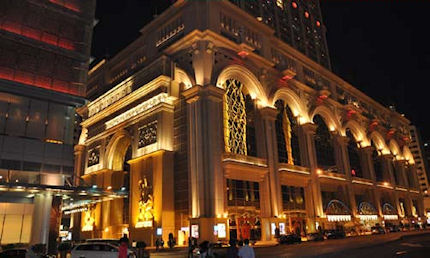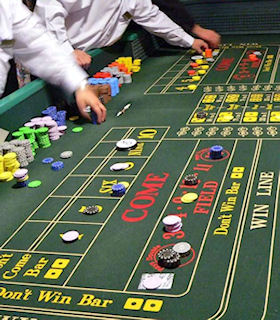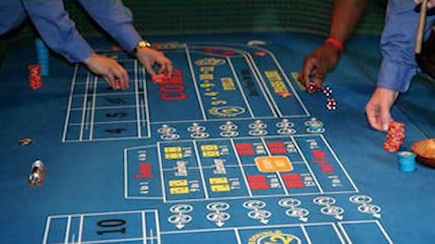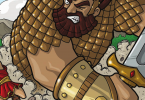Welcome to the final part in our craps series. We are going to explain some of the language used at the craps table. The game of craps really does have its very own language. At a busy craps table, things can get quite noisy and there are certain numbers and terms that sound alike, such as ‘seven’ and ‘eleven’, or ‘five’ and ‘nine’. To avoid confusion in such instances, alternate terms are used. You will find that most of the terminology referred to in this article is used exclusively at the craps table and nowhere else in the casino. If you don’t know some of these terms you could be left completely dazed at a craps table and wondering what the heck people are talking about!

The terminology that is used at the craps table originated in the US many decades ago and therefore these expressions have a strong American influence. It is not possible to include every single expression used at a craps table since the terminology is endless but we have included the popular terms that you are likely to encounter.
Let’s start with the staff at a craps table.
Boxman: the boxman is the person that you see sitting down behind the table just in front of the chips. It is his (or her) job to make sure that the game runs smoothly, the payouts are made correctly and to resolve any disputes. He is the most senior staff member at the table.
Dealer: there are two dealers at a craps table, one at each end, either side of the boxman. Their job is to place the chips in the correct positions on the layout and to make the payouts once the bets are decided.
Stickman: the stickman is the person on the players’ side of the table with the big stick. It is his (or her) job to call the numbers that are thrown and also to collect the dice from the table with the stick that has a hook on it to drag the dice back from the end of the table. The stickman also looks after the proposition bets in the middle of the table (see part D of this series at www.WGM8.com for an explanation of the proposition bets).
Now let’s learn the names called out for the various numbers that can be rolled up on the dice:
2 – ‘snake eyes’
3 – ‘ace deuce’ or ‘acey deucey’
4 – ‘little Joe’ or ‘little Joe from Kokomo’. It is rumoured this relates to Joe Fohn, a famous bowler in the 1920s who was called ‘Little Joe from Kokomo’. He had a four-step delivery.
5 – ‘five, five, no field five’. No field five is mentioned to ensure that it is not confused with nine, and that ‘field’ bets are not paid when a five is rolled. See part D of this series on our website for an explanation of the ‘field’ bet. Some dealers also call ‘five, fever, fever in the funhouse’.
6 – ‘sixie from Dixie’
7 – ‘seven out, line away’ (it’s also called ‘the Devil’, but this is rarely used)
8 – ‘eighter from Decatur’
9 – ‘nina, nina from Pasadena’
10 – ‘the big dick’ (10 is the so-called ‘big dick’, surely a reference to the size of a certain part of a gentlemen’s anatomy!)
11 – ‘yo leveen’ or simply ‘yo’. The word ‘eleven’ is never said in full at a craps table as it can easily be confused with ‘seven’
12 – ‘boxcars’

Now this is where it gets interesting with some terms that you will have never heard of before. Some of the terms presented in this section have been described in previous articles but there are some here that will be totally new to you.
bones: a term used for the dice
they’re coming out: the dice are about to be rolled on the come out roll (explained in part A of this series)
hands high, dice fly: a term used to alert players that the dice are about to be rolled and to remove hands from the table so the dice don’t hit them
seven out, last come will get some: a term used by the stickman after a seven is rolled in the point cycle (for an explanation of the point cycle, see part A of this series).
lines away the don’ts to pay: when a seven-out is rolled all line bets lose but the players that have bet on the don’ts will win their bets (see betting the don’ts in part E of this series).
same dice: when dice fly off the table players will often request to roll the same dice and to do this they must call ‘same dice’ quickly after rolling the dice off the table. The dice have to be checked by the boxman and then will be returned to the shooter and the game will continue.
behind the line: a term used to describe odds taken on a line bet (see part A for a more detailed explanation).
box numbers: the numbers in the boxes in the middle of the table. Box numbers are 4, 5, 6, 8, 9 and 10.
cold table: a table where no one can get any decent roll going and there are no hot shooters.
in the wood, no good: when a die comes off the table and lands in the chip rack. In this case the roll is void.
hardway: a roll made up of a pair of 2s, 3s, 4s or 5s.
long and strong: a term used by the stickman when he wants a player to throw the dice hard to ensure they hit the back wall of the table
natural: a roll of seven or eleven on the come-out roll
press: this is a term used to tell a dealer to increase a bet by doubling its original amount, although it can be used to increase a bet a certain amount if you specify that amount to the dealer
As mentioned earlier, a lot of these terms originated in America and therefore have a strong American influence. As craps grows in popularity in Asia we may find in years to come some home grown Asian craps terms. One thing is for certain though, as long as there is a game of craps an 11 will be ‘yo’, a 2 will be ‘snake eyes’ and if you’ve never played the game before you won’t have a clue what people are talking about!







